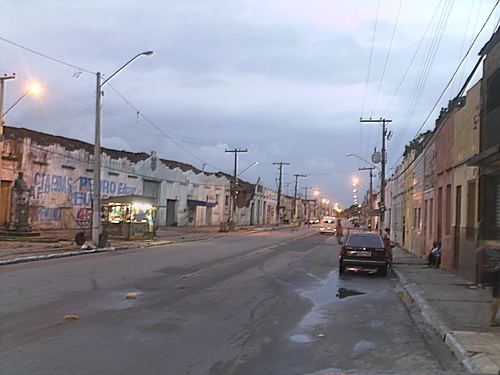Country Brazil State Pernambuco Time zone UTC-3 (UTC-3) Area 501.2 km² Population 78,618 (2015) | Region Northeast Founded August 3, 1892 Postal Code 55900-000 Elevation 13 m Local time Thursday 12:22 AM | |
 | ||
Weather 25°C, Wind SE at 6 km/h, 89% Humidity | ||
Goiana is a city in Brazil in the northeast of the state of Pernambuco, about 65 km north of the city of Recife.
Contents
Map of Goiana, State of Pernambuco, Brazil
Location
It is built on a fertile plain between the rivers Tracunhaém and Capibaribe mirim near their junction to form the Goiana River, and is 25 km from the coast. It the easternmost city in Pernambuco, and the northernmost coastal city of the state. It is surrounded by, and is the commercial centre for, one of the richest agricultural districts of the state, which produces sugar, rum, coffee, tobacco, cotton, cattle, hides and castor oil. Goiana is one of the oldest towns of the state, and was occupied by the Dutch from 1636 to 1654.
The municipality contains most of the 6,677 hectares (16,500 acres) Acaú-Goiana Extractive Reserve, a sustainable use conservation unit created in 2007.
History
Originally occupied by Indians Caetés and potiguaras, the town of Clonmel led is one of the oldest centers of settlement of the region and has at various times, seat of the captaincy.
The village was elevated to a parish in 1568 when Dias Diogo, a Christian of many new possessions, bought from D. Jerome de Albuquerque Sousa 10 thousand fathoms of land near the present city of Goiana, then Captaincy of Itamaracá, establishing a fortified ingenuity in the Valley of the Rio Tracunhaém. This has been the settler attack on the ingenuity Tracunhaém in 1574, in which Indians potiguara he exterminated the entire population of ingenuity. This episode caused the extinction of captaincy of Itamaracá and the creation of captaincy of Nova Paraíba.
In January 1640 went up between Goiana and the island of Itamaracá the squad of D. Fernando de Noronha, Count of Torre, and the Dutch, commanded by Corneliszoon Willen, a fight that would be immortalized in four prints of Frans Post.
On April 24 of 1646, fitted with sticks, stones, pots, pepper and boiling water, women of Tejucupapo, a small district of the city, won the Dutch that threatened their land and families. Event known and portrayed in this movie called "Epic of heroin of Tejucupapo" that the last Sunday of April is recount through a theatrical outdoor milestone in the Mother's Club. The production shows the lives of women who fought against the invaders and against prejudice.
Elevated to the post of town on January 15 of 1685, the city has earned forums on May 5 of 1840, the center of town on August 3 of 1892.
Beaches
Which means in English beef meat is the first beach from the North coast of Pernambuco. Has a narrow sand strip, small waves and, when at low tides banks of sand before the natural reefs . It is located in a small village with few homes and a vast area of coconut trees. To the North, is the mouth of the Goiana River and to the South, is the small Doce river.
Has weak waves, fine sand and lots of algae on the water. Is located in the urban core of the village, where several fishermen boats are always anchored. Together, with Carne de Vaca beach are the most popular beaches in Goiana.
This beach still retains some of native atlantic forest vegetation.
Has clear water, reefs and wet sand. At low tide, there are sand banks, stones and natural pools. It is located close to the village center, where is a church in devotion to Nossa Senhora da Penha - Our Lady of Penha.
Fishermen village, close to the intersection between Itapessoca River and Santa Cruz channel. In town, there is a chapel dedicated to Saint Sebastian.
Has palm trees, mangrove and holidays summer houses. It is located in a private property farm. To access this beach, just between Carne de Vaca and Pontas de pedras beach.
Economy
The main economic activities in Goiana are based in the automotive, pharmaceutical and glass industries, hosting three important plants in these segments. The city hosts the most modern assembly plant of the Fiat Chrysler Automobiles (FCA Group), which is responsibly for the production of the Jeep Renegade and Fiat Toro. Goiana also is the land of Vivix, one of the biggest float glass industry in Brazil and Hemobrás, which produces blood derivatives and coagulation factor products.
Goiana has an important agribusiness sector, especially related to the creation of goats, cattle, pigs, poultry; and plantations of sugarcane and coconuts.
The city is one of the biggest national producer of sugarcane, with an estimated production of over 1.1 million tons in 2007.
Economic Indicators
Economy by Sector 2006
